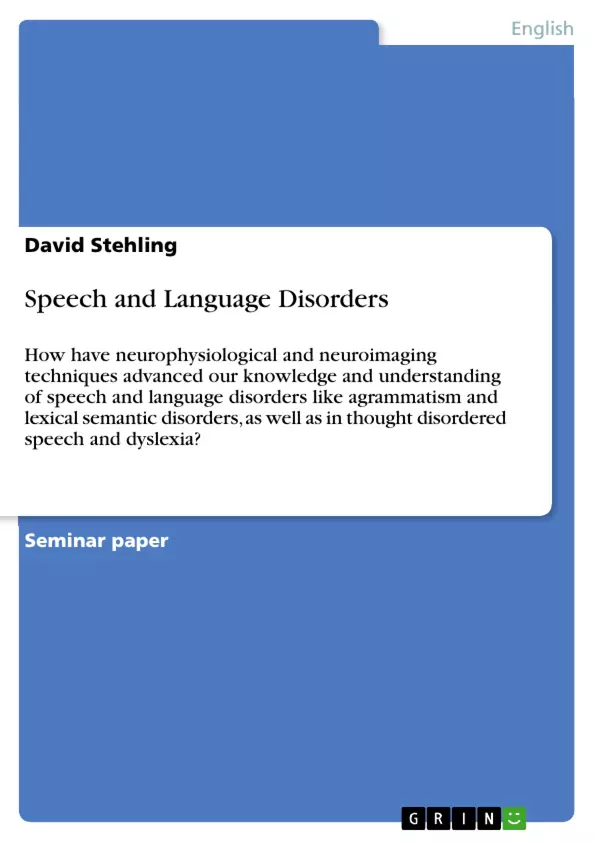Language is the specific human form of communication. In this process, ideas, thoughts, and conclusions can be provided verbally or in writing. Hence, language is medium through which people communicate and it serves as a means of orientation for an individual in his/her environment, which is characterized by visual and aural inputs.
Language comprehension and language processing, due to their complexity, belong to higher brain functions, which are objects of research in lots of different disciplines. The technical methods of neurophysiology have been in extensive progress since the 1950s. These methods enable researchers to examine the functions of brain activities, such as language processes. This neurophysiological progress also supports the research of speech and language disorders, such as aphasia and agrammatism, dyslexia, and thought disordered speech (as in schizophrenia). As a consequence, causes of the disorders and possible therapies (i.e., if they are successful or not) are studied.
The presented essay deals with the topic, how neurophysiological and neuroimaging techniques have advanced our knowledge and understanding of speech and language disorders, especially of lexical semantic disorders (aphasia including agrammatism), as well as thought disordered speech (schizophrenia) and dyslexia. In order to discuss this issue, the theoretical background of these disorders will be considered to discuss the functions of the respective techniques in each case. The techniques are briefly described in advance to provide the basis for the discussion.
Inhaltsverzeichnis (Table of Contents)
- Introduction
- Neurophysiological and Neuroimaging Techniques
- Aphasia and Agrammatism
- Dyslexia
- Thought Disordered Speech - Schizophrenia
- Conclusion
Zielsetzung und Themenschwerpunkte (Objectives and Key Themes)
This essay examines how neurophysiological and neuroimaging techniques have improved our understanding of speech and language disorders, particularly lexical semantic disorders (aphasia including agrammatism), as well as thought disordered speech (schizophrenia) and dyslexia. The essay explores the theoretical background of these disorders and investigates the applications of the techniques in each case.
- Neurophysiological and neuroimaging techniques in language research
- Understanding the neurobiological basis of speech and language disorders
- Examining the role of specific brain regions in language processing
- Investigating the neural mechanisms underlying different types of aphasia
- Exploring the impact of neurophysiological techniques on the diagnosis and treatment of language disorders
Zusammenfassung der Kapitel (Chapter Summaries)
The introduction discusses the significance of language as a human form of communication and highlights the importance of research in this field. It introduces the essay's focus on the advancement of our knowledge of speech and language disorders through neurophysiological and neuroimaging techniques.
The chapter on neurophysiological and neuroimaging techniques explores the use of event-related potentials (ERP) derived from electroencephalography (EEG) and functional magnetic resonance imaging (fMRI) in language research. ERP is used to analyze brain activity in relation to language processing, while fMRI allows scientists to visualize metabolic processes related to brain activity.
The chapter on aphasia and agrammatism examines the historical discovery of Broca's and Wernicke's areas and their roles in speech production and language comprehension, respectively. It defines aphasia as a lexical semantic disorder caused by neurological injury, describes common types of aphasia (Broca's, Wernicke's, and anomia), and discusses the impact of these disorders on speech and language abilities.
The chapter on dyslexia focuses on the neurological underpinnings of this learning disorder, examining how neuroimaging techniques can help in identifying and understanding the brain areas involved. It explores the use of fMRI in visualizing brain activity related to reading and language processing in individuals with dyslexia.
Schlüsselwörter (Keywords)
The primary keywords and focus topics of this text include neurophysiological techniques, neuroimaging techniques, event-related potentials (ERP), functional magnetic resonance imaging (fMRI), speech and language disorders, aphasia, agrammatism, dyslexia, thought disordered speech, schizophrenia, lexical semantic disorders, brain regions, language processing, language comprehension, language production, diagnosis, treatment, and neurobiology.
- Citation du texte
- David Stehling (Auteur), 2009, Speech and Language Disorders, Munich, GRIN Verlag, https://www.grin.com/document/205523



